
County Mayo is a county in Ireland. In the West of Ireland, in the province of Connacht, it is named after the village of Mayo, now generally known as Mayo Abbey. Mayo County Council is the local authority. The population was 137,231 at the 2022 census. The boundaries of the county, which was formed in 1585, reflect the Mac William Íochtar lordship at that time.

Killala is a village in County Mayo in Ireland, north of Ballina. The railway line from Dublin to Ballina once extended to Killala. To the west of Killala is the townland of Townsplots West, which contains a number of ancient forts. Historically associated with Saint Patrick, and the seat of an episcopal see for several centuries, evidence of Killala's ecclesiastical past include a 12th-century round tower and the 17th century Cathedral Church of St Patrick. As of the 2016 census of Ireland, the village had a population of 562.

Abbeyfeale is a historic market town in County Limerick, Ireland, near the border with County Kerry. The town is on the N21 road from Limerick to Tralee, some 21 kilometres south-west of Newcastle West and 16 kilometres south-east of Listowel and 38 kilometres north-east of Tralee. The town is in a civil parish of the same name.

Headcorn is a village and civil parish in the borough of Maidstone in Kent, England. The parish is on the floodplain of the River Beult south east of Maidstone.
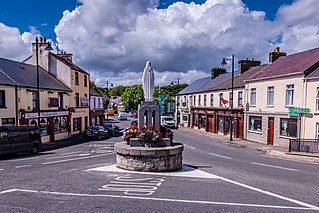
Crossmolina is a town in the historical barony of Tyrawley in County Mayo, Ireland, as well as the name of the parish in which Crossmolina is situated. The town sits on the River Deel near the northern shore of Lough Conn. Crossmolina is about 9 km (5.6 mi) west of Ballina on the N59 road. Surrounding the town, there are a number of agriculturally important townlands, including Enaghbeg, Rathmore, and Tooreen.
Moyvane, also sometimes known as Newtownsandes, is a small village in County Kerry in the south west of Ireland. It is situated off the N69 road between Listowel to the southwest and Tarbert to the north. The village of Knockanure lies to the immediate south. The parish in which the village is located is now also known as the "Parish of Moyvane". It was originally called the parish of Murhur, which was part of the historic barony of Iraghticonnor.
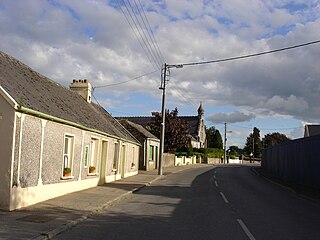
Murroe, officially spelled Moroe, is a village in County Limerick, Ireland.
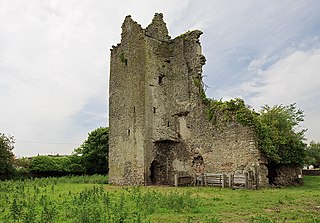
Borrisoleigh is a small town in County Tipperary, Ireland. At the 2016 census, it had a population of 679. It is in the ecclesiastical parish of Borrisoleigh and Ileigh in the Roman Catholic Archdiocese of Cashel and Emly.
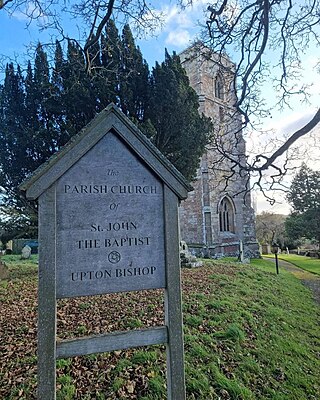
Upton Bishop is a small village in Herefordshire, England. The population of the village at the 2011 census was 602.

Moydow is a village on the outskirts of Longford town in County Longford, Ireland.

The Diocese of Killala is a Latin Church diocese of the Catholic Church in Connacht; the western province of Ireland. It is in the Metropolitan Province of Tuam and is subject to the Metropolitan Archdiocese of Tuam. As of 2023, the bishop is John Fleming, who was appointed on 7 April 2002.

Kilmovee is a village and civil parish in County Mayo, Ireland. It is a mainly rural parish on the R325 road, midway between Kilkelly and Ballaghaderreen.

Adamstown is a village in County Wexford, Ireland. It is about 24 km (15 mi) north-west of Wexford, 20 km (12 mi) east of New Ross, and 20 km (12 mi) south-west of Enniscorthy.

Mahoonagh or Castlemahon is a village and civil parish in County Limerick, Ireland. The village lies four kilometres south east of the town of Newcastle West.
The Conmhaícne Mheáin Maigh or Conmaicne Mhein or Conmaicne Máenmaige or Conmaicne Críche Meic Erca were an early people of Ireland, their tuath comprising the barony of Loughrea, in County Galway.
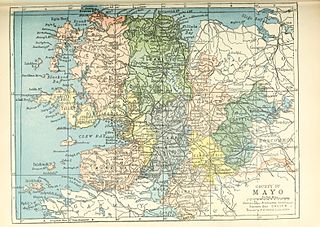
Tirawley, archaically known as Tyrawley, is a barony extending southward from the north coast of County Mayo, Ireland. It was created during the shiring of County Mayo out of the Gaelic túath or territory of Tír Amhlaidh, from which it takes its name.
Fr. Brendan Hoban is an Irish Catholic priest in the Killala Diocese, columnist and author of a number of books. Fr. Hoban was born in Ballycastle, Co. Mayo in 1948. Educated in Ballycastle Boys National School, St Muredach¹s College, Ballina and entered St Patrick's College, Maynooth in 1966 and was ordained for the diocese of Killala in 1973. He writes a weekly column in the Western People.

Ballina is a town in north County Mayo, Ireland. It lies at the mouth of the River Moy near Killala Bay, in the Moy valley and Parish of Kilmoremoy, with the Ox Mountains to the east and the Nephin Beg mountains to the west. The town occupies two baronies; Tirawley on the west bank of the Moy River, and Tireragh, a barony within County Sligo, on its east banks. At the 2022 census, the population of Ballina was 10,556.

Gub, an Anglicisation of the Gaelic, 'Gob', meaning The Headland, is a townland in the civil parish of Templeport, County Cavan, Ireland. It lies in the Roman Catholic parish of Glangevlin and barony of Tullyhaw. It is also known as Garvalt Upper. It contains part of the village of Glangevlin.
Enaghbeg is a townland located in the Barony of Tirawley, in the County of Mayo. It is in the Electoral Division of Deel, in a civil parish of Crossmolina. Agriculture is the primary economic activity.



















